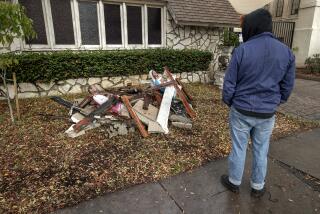Home Sellers Use Statues for Luck : Icons: Figures of St. Joseph are considered helpful in a sluggish market. Some clerics voice skepticism.
- Share via
SYRACUSE, N.Y. — When Connie Palumb put her house up for sale last year, she made sure it sparkled from floor to ceiling. Then she did something even the most eagle-eyed home buyer wouldn’t notice. She buried a plastic statue of St. Joseph, the patron saint of carpenters, in her yard.
The house, which was marketed without a real estate agent, attracted a buyer within 10 days. “And that’s unusual in this market,” Palumb said.
Keenly aware of the sluggishness of the real estate market, many homeowners with the earthly ambition of selling their property are burying small plastic statues on their land, hoping for divine intervention.
“We go through easily 1,000 [St. Joseph] statues a year,” said Steve DeSantis, owner of the Catholic Shop in Syracuse.
Starting in May, the beginning of peak real estate season, the demand for the statues “just went crazy,” said DeSantis, who sells a St. Joseph home sale kit that includes a six-inch plastic statue, laminated prayer card and instruction sheet for $4.17.
Property owners from Boston to Phoenix--and in many states in between--have been burying the statues, hoping to change their luck and land a sale.
“It was very big four or five years ago and I’ve seen a resurgence again this year,” said Mike Greene, president of the Brooklyn-based Panation Inc., a manufacturer and distributor of religious items. “We’ve run out of stock because this [demand] was not foreseen.”
Many Catholics and even non-Catholics believe in a statue’s power to sell a house, but church officials and theologians aren’t so quick to make the connection.
“Magic is always corruptive of authentic religion . . . and the whole notion of God’s omnipotence,” said William Dinges, associate professor of religion at Catholic University in Washington.
Catholics believe St. Joseph was the husband of the Virgin Mary and foster father of Jesus. Besides being the patron saint of carpentry and the family, St. Joseph is regarded as the protector and provider, DeSantis said.
When customers inquire about the statues of St. Joseph, DeSantis doesn’t advise them either way, but he clearly is uncomfortable with the idea. “In my opinion it borders on the superstitious,” he said.
Thomas Costello, auxiliary bishop of the Diocese of Syracuse, shares the same concern. “Beware of superstition. . . ,” he said. “It’s a gimmick.”
Costello views the practice of burying a statue of St. Joseph with the same skepticism he reserves for turning a statue of the Virgin Mary toward the sun so it won’t rain on a day you’re planning a picnic. “I think,” he said, “that Mary has bigger fish to fry.”
Yet, faced with a buyer’s market, some home sellers are willing to take unorthodox routes to sell their property.
“From a realistic standpoint, price is the most important factor” in selling a house quickly, said Dave Hanlon, president of the Greater Syracuse Assn. of Realtors. “But all things being equal, [burying a statue of St. Joseph] can’t hurt. Who knows? God works in mysterious ways.”
The practice apparently is an ancient one in Europe. Until recently, it had been confined to American neighborhoods with strong ethnic ties, particularly Italian and Polish enclaves.
There are numerous theories on how the practice began. According to the instruction sheet included in the Catholic Shop’s kit, it is thought to have stemmed from the work of a Canadian named Brother Andre Besette.
Besette built a chapel in honor of St. Joseph outside Montreal that later became the site of purported miracles in the late 19th and early 20th centuries. But priests at the Oratory of St. Joseph in Quebec said they never heard of the practice.
During the Middle Ages nuns often buried medals bearing the image of St. Joseph on land they wanted to buy or safeguard, officials of the Washington-based Catholic Information Center have said. Over time, lay Catholics continued the tradition, replacing medals with statues made of plaster--and now of plastic.
More to Read
Inside the business of entertainment
The Wide Shot brings you news, analysis and insights on everything from streaming wars to production — and what it all means for the future.
You may occasionally receive promotional content from the Los Angeles Times.










